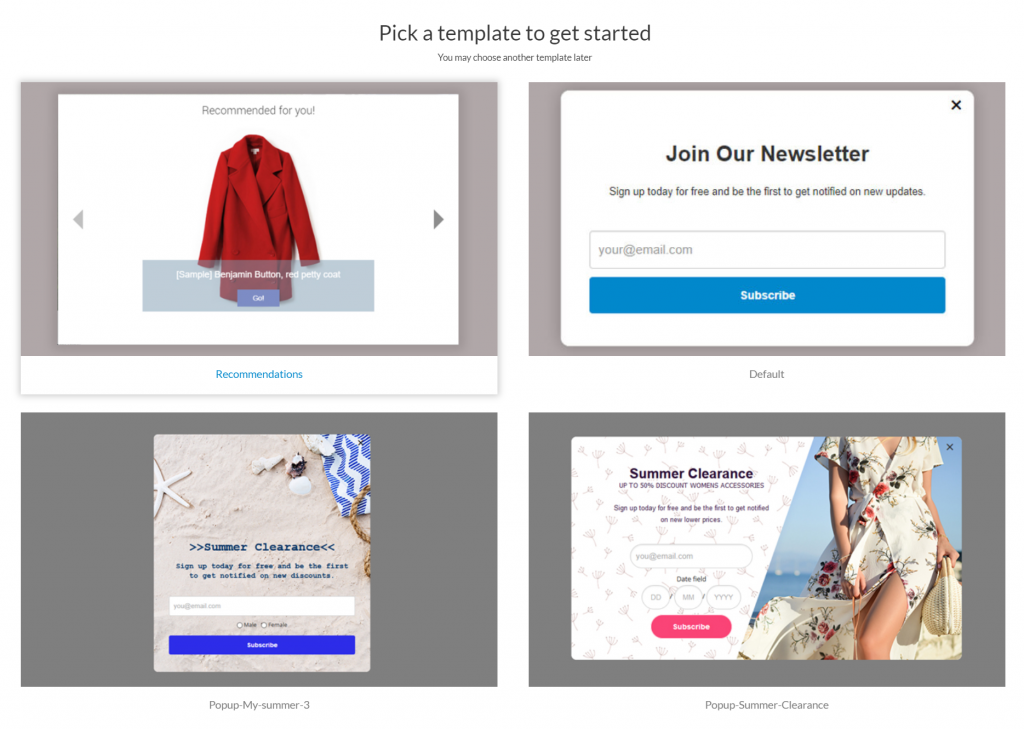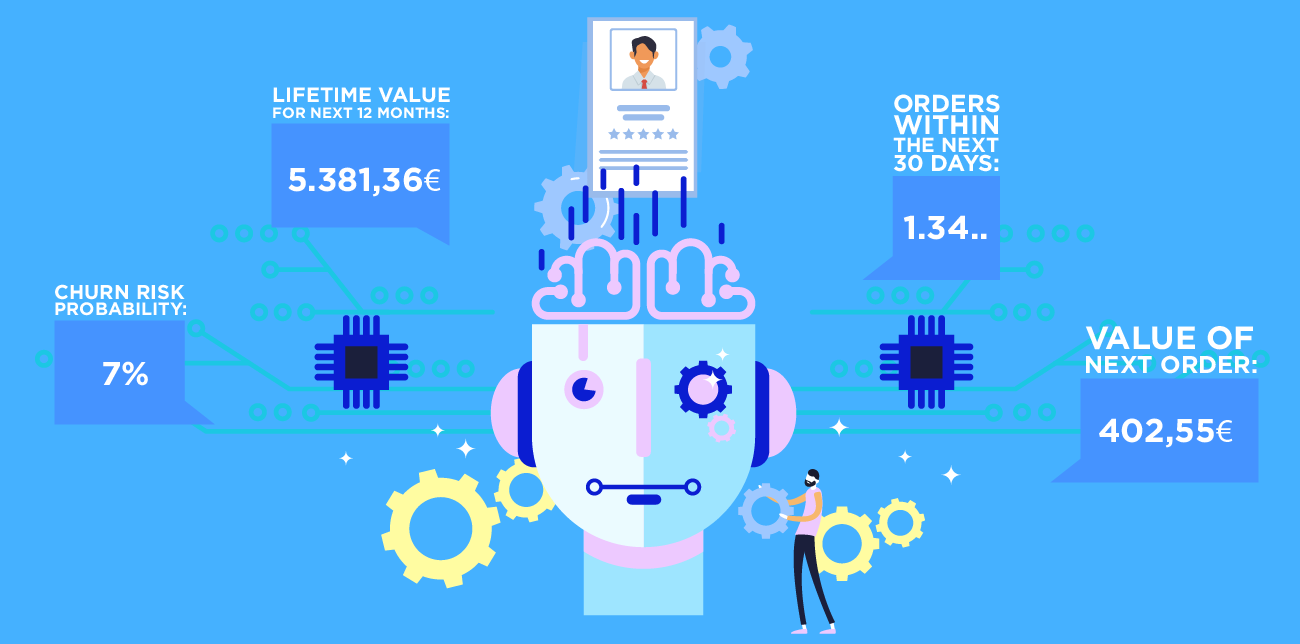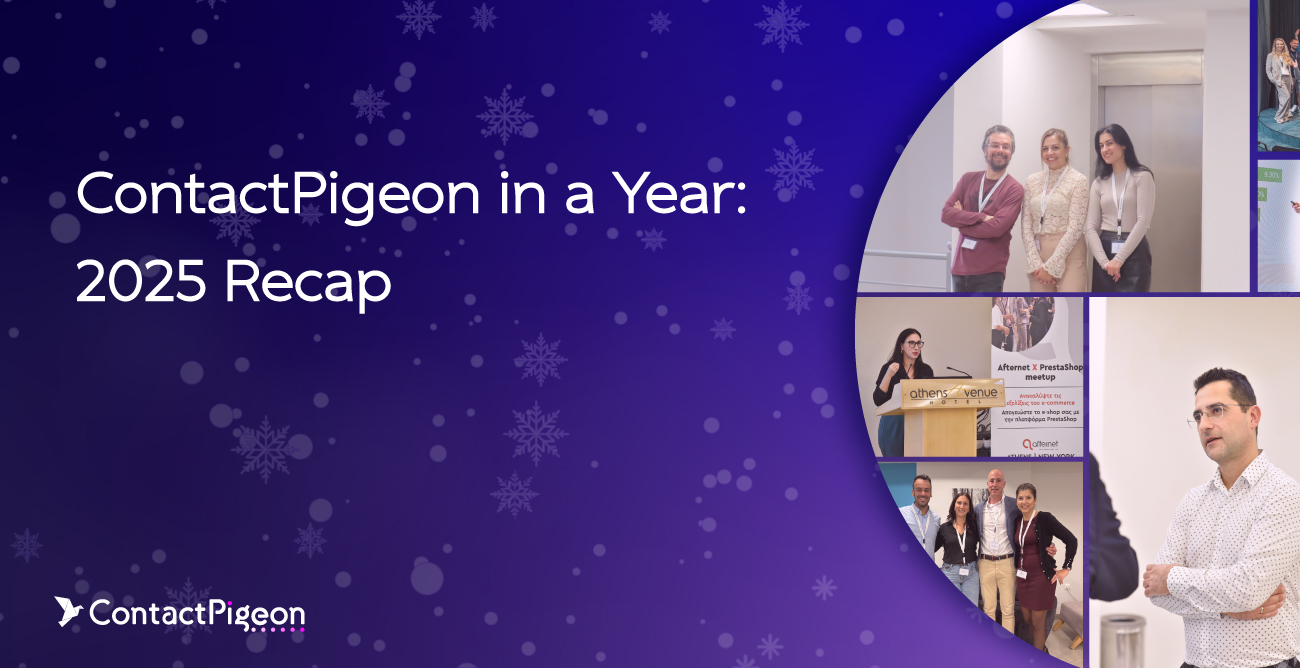It’s no secret that better insights to customers lend an edge to your marketing success. After all, who wouldn’t want to know each customer’s lifetime value (CLV) or when the next order will be? Every day, your online business generates a massive volume of data from a wide range of sources – online and offline – at a faster pace than you can interpret with traditional methods. The dataset is a treasure trove that’s waiting to be mined, and the only way to tackle it is through advanced data science.
That’s why we are excited to announce the launch of a new AI feature: Predictive Insights on Customers. This new feature will unlock new ways to explore your data for customer segmentation, marketing automation, and campaign designs.
Predictive Insights is already live in ContactPigeon, accessible as data fields within each Contact Profile.
How Does Predictive Insights Work?
Predictive analytics uses past data to provide accurate predictions of future events. We focus the analytical model on identifying individual customers and their needs as time progresses by answering key questions such as the following:
- When will the customer likely make the next purchase?
- How much money will she spend with me on the next order?
- Which products will she most likely purchase next?
- What’s the probability of churn for my customer?
- What’s the customer lifetime value (CLV) of this customer?
To assign a score for the above attributes to each customer, we take data input from two properties: events and customer attributes. ContactPigeon requires an individual profile to have recorded at least two orders and one month of eCommerce history to begin building the predictions. Of course, the bigger the data set, the more accurate the forecast will become.
The Predictions
Here is a look at what Predictive Insights captures.

Orders Within Next 30 Days / 2 Months / 3 Months / Year
This set of stats refer to the number of orders the customer is predicted to make within the next periods. The estimate is based on customer’s purchase patterns up to the time this metric is calculated and reflects the likelihood to purchase within a specific timeframe.
Since this number is an approximation, it often appears as a decimal rather than a round number.
Churn Risk
Churn risk is a measure of immediate future risk of losing the customer (one that will no longer buy from you).
Value of Next Order
Value of Next Order predicts the amount of money the customer will likely spend on his next order.
Customer Lifetime Value For Next 12 Months
This metric is the predicted total order value (or worth) the customer is expected to spend with your business within one year.
Recency Cluster
Recency cluster is the allocated cluster the customer belongs to based on the recency of her last purchase. The four clusters range from 0 to 3, with 3 being the cluster with the most recent purchases.
Revenue Cluster
Revenue cluster is the allocated cluster the customer belongs to based on the total lifetime spend. The four clusters range from 0 to 3, with 3 being the cluster with the highest order value.
Frequency Cluster
Frequency cluster is the allocated cluster the customer belongs to based on the frequency of the order placed. The four clusters range from 0 to 3, with 3 being the cluster with high-frequency buyers.
Overall Score
This is the sum of all cluster scores (recency, revenue, and frequency). It ranges from 0 through 9.
Predicted Segment
This is ContactPigeon’s categorization of the customer against the rest of your customer population. There are three segments:
- Low Value (LowV) – Customers who are less active than others, make infrequent visits and purchases to your business and generates low value (near zero or negative) in revenue.
- Mid Value (MidV) – This segment captures those who are middle of the pack. The customers bring moderate revenue value to your business and interact with your brand sporadically.
- High Value (HighV) – This is the group you don’t want to lose. They bring high revenue, as well as shopping or interacting with your brand frequently.
Predictive Product Recommendation Pop-up
Alongside the various ways for segmenting your audience with predictive stats, we have introduced a nifty feature to promote predictive product recommendations to your web visitors.

The product recommendation pop-up is now a standard template you can find within the ContactPigeon dynamic pop-up builder. For example, you can trigger the product recommendations when someone is about to leave your site, or as an up-sell recommendation when the visitor has added a product to cart to increase the cart value.
The product recommendations are generated based on the visitors’ recent web behaviors – such as product viewed, added to cart, or purposed – combined the overall insights of product across the entire population of your audience to determine products that are most likely purchased together.
Setting it up can’t be easier. Simply choose the “Recommendation” template, follow the setup instructions to determine when and where the pop-up will show up, and the recommendation is ready to be activated.

The Model Behind
For the clustering assignments, we adopted the RFM model. RFM is a marketing analysis tool that quantifies customer segments on three key factors: recency, frequency, and monetary (revenue).
- Recency measures how much time has elapsed since a customer’s last activity or transaction with the brand? Often, the more recently a customer has interacted with a brand, the more likely the customer will be responsive to the brand’s communications.
- Frequency looks at how often a customer interacted with the brand during a particular period. Customers with frequent activity are more engaged, and therefore, more “valuable” or loyal to your business.
- Monetary, also referred to as “monetary value,” measures the total spend a customer made with the brand. Identifying potential High Spenders allow you to nurture them better as they should be treated differently than those who spend less.
These factors, combined with modeling customer behavior with the probability distribution across a normalized population, are used in our model to estimate the future outcomes of the customer.
Use Cases for Predictive Insights
To fully understand the true power of predictive insights, let’s take a look at some marketing use cases that can be deployed to boost your marketing effectiveness.
 | Prefect Campaign Timing Knowing when a customer is likely to make the next purchase can help you plan and run targeting reminders at the optimal time. Removing redundant communication saves time and money (think CPC spend) by targeting fewer customers while achieving similar or improved results. |
 | Targeted Product Recommendations Showcase products that customers are more likely to be interested in can boost conversion outcomes. |
 | Prevent Churn Highlight individuals who are most likely to churn, and take actions to remediate the churn before it happens. |
 | Optimized Offers for Profitability Plan promotional offers strategically by aligning offers to the value of the customer to your business. Overcompensating a “low-value” customer may lead to lower profitability, which ultimately may hurt your business. |
A Caveat to Consider
Predictive insights are a powerful tool for optimizing your marketing effectiveness and enhance customer engagements. But no one can predict the future to perfect accuracy, particularly on an individual basis where results may be skewed by outliers. Predictions work best when averaged across the majority of the customer population. Hence, the larger the population size, the more accurate the average prediction will be.
Furthermore, such a predictive model is, by its nature, an historical method. It looks at past customer behavior data to predict future activities, preferences, and responses. As a result, the predictions assume the continuity of a similar pattern and doesn’t account for extraordinary events that may significantly alter consumer behaviors (such as the market disruptions from COVID-19).
Predictive Insights FAQ
Q: How are product recommendations generated?
Our predictive insights takes into account multiple factors when generating product recommendations. These factors include:
- Past orders
- Browsing pattern
- Similar products purchased across all customer base
- Recency of behaviors
Q: How will the embedded recommendations show for my site?
The product recommendations follow the pop-up trigger rules you have defined. So you can choose the condition for their appearence on your site – whether if they appear on-load, on-exit, when someone add an item to cart, or any other triggers ContactPigeon supports.
Q: How do I set the correct placement options?
There are a number of default placement positions for pop-ups. To designate a custom placement, you will need to contact your account manager to help you with the specifics, as each website is different.
Q: I don’t like how the product image is displayed, can I change this?
The template can be customized like every other pop-up. Some more advanced web designer knowledge may be neccessary for the optimal viewing result.
Activate Your Data Powered Marketing
With the launch of Predictive insights, ContactPigeon is excited to be unlocking the ability for retailers to act and engage with customers in advance of the transactions.
It enables our clients to drive more value from their marketing efforts and therefore sets them apart in the competitive eCommerce landscape.
Looking to understand how to active your Predictive Insights powered marketing campaigns? Request a chat to see how Predictive Insights can unlock your digital potential!

Let’s Help You Scale Up
❤️ Thanks to ContactPigeon Product Team




